#mango exporting countries
Explore tagged Tumblr posts
Text
How Does Mango Export from India Work?

Mangoes are one of India's most cherished fruits, often referred to as the "King of Fruits." With their rich flavor and variety, Indian mangoes are in high demand globally, making mango export from India a thriving business. But how does this process work? What are the key factors involved? In this article, we’ll answer important questions about mango export from India, the list of mango exporters in India, and much more.
Why is Mango Export from India Significant?
Why is India a Major Player in Mango Exporting Countries?
India is the largest producer of mangoes globally, contributing significantly to the global supply. With diverse climatic conditions, India can produce a wide variety of mangoes, each with its unique taste, texture, and aroma. Varieties like Alphonso, Kesar, and Dasheri are particularly famous, not just within India but also in international markets.
What Makes Indian Mangoes Popular Globally?
Indian mangoes are renowned for their rich flavor, sweetness, and unique taste that is unmatched by mangoes from other regions. The Alphonso mango, often considered the best in the world, has a creamy texture and a sweet, aromatic flavor that is highly sought after in countries like the USA, UAE, and the UK.
How Does Mango Export from India to the USA Work?
What are the Steps Involved in Mango Export from India to the USA?
Exporting mangoes to the USA involves several critical steps:
Compliance with Phytosanitary Standards: Mangoes must meet the USA’s stringent phytosanitary standards, which include inspection for pests and diseases.
Irradiation Treatment: To ensure that mangoes are pest-free, they often undergo irradiation treatment, a process approved by both Indian and US authorities.
Packaging and Labeling: The mangoes must be properly packaged to maintain their quality during transit. Labels must include all necessary information, including country of origin and treatment details.
Shipping: Mangoes are usually shipped by air to ensure freshness upon arrival.
What Are the Challenges in Mango Export from India to the USA?
Exporting mangoes to the USA is challenging due to strict regulations and the need for high-quality standards. The process is expensive, requiring investment in proper treatment and certification. Moreover, the transit time is critical; mangoes must reach the market while still fresh, which requires careful planning and logistics.
What Does Mango Export Data Tell Us?
What Are the Key Insights from Recent Mango Export Data?
Mango export data reveals that India consistently ranks among the top exporters of mangoes globally. The data shows that the USA, UAE, UK, and Europe are the primary markets for Indian mangoes. Over the years, the demand for Indian mangoes has been steadily increasing, with Alphonso mangoes being the most exported variety.
Who are the Largest Exporters of Mango in India?
The largest exporters of mango in India are companies that specialize in fresh produce export. These companies have established connections with international markets and comply with all necessary export regulations. A few prominent names include:
Devgan Impex: Known for exporting Alphonso mangoes to the USA and Europe.
Kay Bee Exports: A major player in the fresh produce export industry, dealing with multiple varieties of mangoes.
Bombay Exports: A leading exporter of mangoes, particularly to the Gulf countries.
Who is on the List of Mango Exporters in India?
Which Companies Dominate the Mango Export Market?
India has a long list of mango exporters, ranging from large corporations to small-scale producers. Some of the key exporters include:
Allana Group: One of the largest agri-exporters, dealing with various fruits, including mangoes.
InI Farms: Specializes in exporting premium quality mangoes to international markets.
Sahyadri Farms: Known for exporting organic mangoes and maintaining high-quality standards.
How Do Small-Scale Exporters Contribute to Mango Export from India?
Small-scale exporters play a vital role in the mango export market by catering to niche markets and offering unique varieties of mangoes. They often focus on organic and pesticide-free mangoes, which are increasingly in demand in health-conscious markets.
How to Export Mango from India?
What Are the Requirements for Exporting Mangoes from India?
To export mangoes from India, several requirements must be met:
Registration with APEDA: The Agricultural and Processed Food Products Export Development Authority (APEDA) oversees mango exports. Exporters must be registered with APEDA.
Phytosanitary Certification: Mangoes must pass phytosanitary inspections to ensure they are free from pests and diseases.
Adherence to International Standards: Mangoes must meet the importing country’s standards for quality, size, and packaging.
Proper Documentation: Exporters must prepare all necessary documents, including the certificate of origin, phytosanitary certificate, and commercial invoice.
What are the Costs Involved in Mango Export from India?
Exporting mangoes involves several costs, including:
Phytosanitary Inspection Fees: Costs associated with ensuring that the mangoes meet international standards.
Irradiation Treatment Costs: Expenses incurred for treating mangoes to make them compliant with importing countries' regulations.
Shipping and Logistics Costs: Air freight is commonly used for mango export, which is expensive but necessary to ensure freshness.
Packaging Costs: Proper packaging is essential to prevent damage during transit and maintain quality.
What is the Role of Alphonso Mango Export from India?
Why is Alphonso Mango Export from India So Significant?
Alphonso mangoes, often referred to as "Hapus," are considered the best mangoes in the world due to their exceptional flavor and texture. They are a major export product for India, especially to countries like the USA, UAE, and Europe.
How Does Alphonso Mango Export Impact India's Economy?
The export of Alphonso mangoes contributes significantly to India's agricultural export earnings. Due to its high demand and premium pricing, Alphonso mangoes help boost the income of farmers and exporters. The reputation of Alphonso mangoes also enhances India's standing in global agricultural markets.
Conclusion
Mango export from India is a vital part of the country's agricultural economy, with the demand for Indian mangoes growing globally. The process of exporting mangoes involves strict compliance with international standards, especially when exporting to countries like the USA. The Alphonso variety, in particular, plays a crucial role in India’s mango export industry. Understanding the dynamics of mango export from India, the key players involved, and the challenges faced can help potential exporters navigate this lucrative market successfully.
FAQs
1. What are the top mango exporting countries?
India, Mexico, Thailand, and the Philippines are some of the top mango-exporting countries globally.
2. How can I start exporting mangoes from India?
To start exporting mangoes from India, you need to register with APEDA, comply with phytosanitary standards, and meet the importing country's regulations.
3. Who are the largest exporters of mango from India?
Devgan Impex, Kay Bee Exports, and Allana Group are among the largest exporters of mangoes from India.
4. What is the significance of Alphonso mango export from India?
Alphonso mangoes are highly prized for their flavor and are one of the most exported mango varieties from India, contributing significantly to the country’s export earnings.
5. What are the main challenges in mango export from India to the USA?
The main challenges include meeting stringent phytosanitary standards, the high cost of irradiation treatment, and ensuring the mangoes reach the market while still fresh.
#mango export from India#Mango export data#list of mango exporters in India#largest exporter of mango#mango export from India to USA#how to export mango from India#Alphonso mango export from India#mango exporting countries
0 notes
Text
Explore the lucrative opportunities in mango export from India. Learn about the top mango varieties, essential export documentation, obtaining licenses, and utilizing HS codes for successful trade ventures.
#mango export from india#mango export data#mango exporters#mango export from india to usa#mango exporter#mango exporting countries#mango hs code
0 notes
Text
https://www.seair.co.in/blog/how-to-export-mango-from-india-to-other-countries.aspx
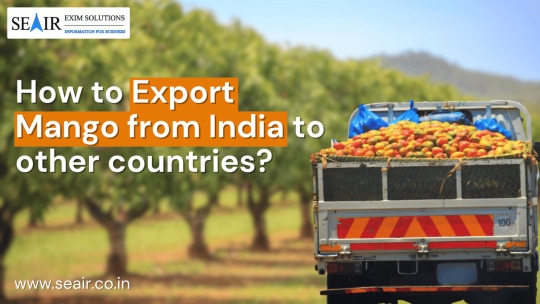
Discover the ultimate guide on mango export from India to other countries? with Seair Exim Solutions' insightful blog. Gain valuable insights, step-by-step procedures, and expert tips to streamline your export process and expand your business internationally.
#mango export from india#mango export data#mango exporters#mango export from india to usa#mango exporter#mango exporting countries#mango hs code
0 notes
Text
How to export mango from India?
Learn about how mango export from India! Explore major exporters, mango varieties, export process, documents, and HS codes. Get actual mango export data instantly.

#mango export from India#how to export mango from India#mango export data#mango export#mango exporters in India#largest exporter of mangoes in India#top mango exporting countries
0 notes
Text
Forging a Path of Growth for Indian Exporters

India is the second largest producer of fruits and vegetables in the world, first being China. It takes lead in producing bananas, mangoes, and guavas, with significant contributions from grapes, oranges, and pomegranates as well. Moreover, India has emerged as a major exporter of fruits, catering to countries like the UK, UAE, Malaysia, and others. Hence, the exporters in India are in high demand and have a good scope for further expansion. However, finding trustworthy importers who make timely payments is quite challenging for an exporter. Late payments, defaults, and inadequate working capital can disrupt your cash flow and hinder the smooth operation of your business.
At Ninja Global, we recognize the challenges you face in ensuring secure trade and managing your cash flow. To mitigate these challenges, we are introducing PaySure, a program that helps you secure export collections and avoid payment defaults. With PaySure, you can become a certified exporter. It opens up new opportunities to plan your business with greater flexibility Learn More- https://ninja-global.com/blog/forging-a-path-of-growth-for-indian-exporters/
#exporters in India#freight forwarding#PaySure#export from india to other countries#exporters in india#secure trade#banana exporters in india#fruits and vegetables exporters in india#fruits and vegetables exporters#fresh mango exporters in india
0 notes
Text
I read an article lamenting how indian mangoes don’t get exported and how bad it is for the economy and how much money we’d make if we could figure out the supply chains as if this country wouldn’t collapse into civil war if in addition to 50°c summers and 10 hr power cuts we had to cope with mangoes becoming unavailable or unaffordable because they’re all being shipped off to whole foods so patricia can pay $15 for one (1) dussehri for her summer salad
2K notes
·
View notes
Text
Kirigakure Worldbuilding II - Specialties
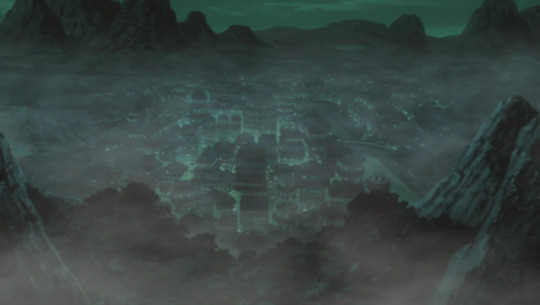
Inspired by a recent conversation I had with @pxssy-stuntin-for-itxchi, I got wanted to add more to my Kirigakure worldbuiling post!
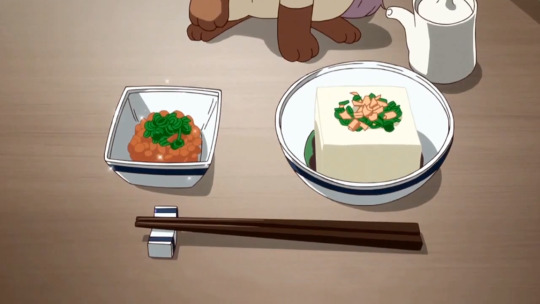
Food Preservation Since except for a month during the winter, it never really gets cold in Kirigakure. This has lead to its citizens becoming very creative at enhancing the shelf life of the food that they have. Meat/fish is dry-aged and smoked, fruits are turned into preserve, cheong, or slow-dried. Dairy is a luxury in the water realm, so there are a lot of plant based dairy alternatives already, so it’s no surprise the wave realm has a quite big vegetarian and vegan population. Even though their spice tolerance is not the highest, when talking SALT tolerance, no village can beat Kiri. They are VERY generous with salting their food. In order to get a smokey flavor to any dish, you can obtain smoked salt everywhere in the country. The water realm was the first region the come up with the concept of fermentation of food. Milk is turned into yoghurt and cabbage is turned into kimchi and its more popular variant - sauerkraut. Fun fact: Suigetsu comes from a high ranking caste, so he actually was able to afford dairy yoghurt and jello with actual gelatine, and they're his favorite foods.
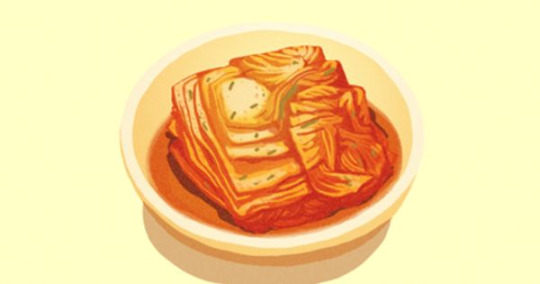
Kimchi and Sauerkraut
The general spice tolerance of Kiri citizens is not the highest across the shinobi world, so kimchi is mostly exported to Konoha and Suna. The cabbage grown in the water realm is specifically bred to be extra heat resistant and crunchy. In order to cut down on waste, the excess is turned into sauerkraut juice. To put less of a strain on the public healthcare system, the water realm government has issued its citizens to exercise and eat healthy – especially children. To get more children to drink sauerkraut juice, it is produced in portable, biodegradable little juice boxes which are handed out for free in the Kirigakure academy. Every Kiri genin has tasted it atleast once. Scurvy was once a big problem for most shinobi going on long term stealth missionas, since most just lived off dried meat and crackers, except for Kiri Nin, since they always carry sauerkraut juice (and kumquats) with them.
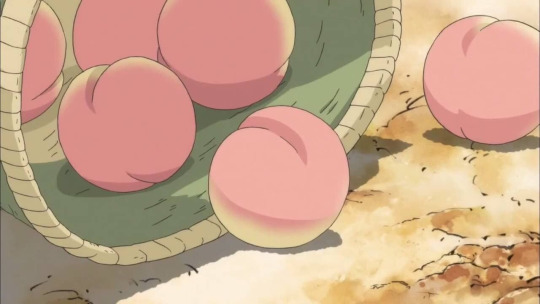
Fruit
Mangos: With their sweet and fruity taste, they’re popular amongst children, especially when dried, rolled into balls with an added sugar crust. While other countries see them as a special treat they’re a staple in Kiri. Papaya: Another Kiri staple. It is eaten either as a fruit in its orange form or in its green form in more hearty dishes. The seeds are ground and sold as a pepper alternative. Its extracts of the are used by the Kiri beauty industry, which is the biggest one, closely followed by Suna's beauty industry. Peaches: Often grown on the mountaintops of the water realm, they’re loved all over the country. Peach trees are seen as a sign of fertility, renewal and good luck. The pits are turned into persipan, which many foreigners don't like. Durian: Those stinky fruit are banned in Kiri’s public spaces. However, it is still the most popular fruit overall, so only a few get exported yearly, much to the other countries' durian lovers' chagrin. Jackfruit: Not a lot of Kiri citizens like its fleshy texture but it is often used as meat alternative by Kiri’s large plant-based population. Lychee: They’re often sugared and canned, or added to jelly. They're amongst the most popular fruit to make cheong with.
Kumquat: Kiri nin love them because they’re basically easily portable, vitamin c filled snacks. Other honorable mentions include: Rambutan, Mangosteen, Starfruit, Cherimoya, Soursop, Yuzu and Tamarillo.

Jelly If you’ve read my last post on Kiri specialties, you probably know that instead of manufactured candy, Sweet tooths (teeth?) in Kiri chomp down on dried fruit, fermented sugary sticky rice and – jelly. Gelatine, like most non fish animal products, is a luxury so most jellies are made with agar-agar, a plant based “gelatine”. Just take some fruit juice and set it with agar – and there you have jelly. Most foreigners find Kiri’s obsession with jelly pudding off-putting, but that doesn’t stop them. Fun fact: Suigetsu comes from a high ranking caste, so he actually was able to afford dairy yoghurt and jello with actual gelatine, and they're his favorite foods. Non food fun fact: As genetic engineering gets more advanced and Kirigakure already having no issues using bacteria, they're also the biggest exporter of nutrient agar for agar plates which are used for the cultivation of bacteria and funghi. Kigakure is the leading village when it comes to biological and medical advancements, which is why Orochimaru has visited very often (and eventually ran into Kimimaro)

#naruto headcanons#naruto shippuden#naruto#naruto imagines#naruto scenarios#akatsuki#naruto fanfiction#headcanons#fanfiction#suigetsu headcanons#suigetsu#naruto meta#kirigakure headcanon#kisame headcanons#kisame hoshigaki#kimimaro#orochimaru#zabuza momochi
107 notes
·
View notes
Text
Mashick
Mashick (Borlish Mascic /maˈxɪk/, Nawat Maishī'co /maiˈʃiːʔ.ko/, Mashick Arabic المشيق · al-Mashīq) is a polity in Lower Mendeva [Mexico and Central America] and in fact by land area the largest polity in all of Mendeva [North America]. At its greatest extent the then-Empire stretched as far northwest as Mivock [northern California].
History
Morrack [Moroccan] vessels of the New World Company established trading relations in the late fifteenth century with the relatively-new Mashick Empire, which at that time was much more geographically restricted. The next decades saw many Novomundine crops make their way across the Atlantic from Mashick, including tashban and shockle [vanilla and chocolate].
Mashick (and, to the south, Tavancy [the Inca]) served as bases for exploration of Mendevan lands. Fleets charted as far afield as the Ax [southern Alaska and the Aleutian islands], and Mashick was used to exercise control over parts of the Arcabil [Caribbean] and their growing riches.
Nineteenth-century Mashick was one of the hotbeds of the nascent political philosophy of Ubiquity. It lagged behind British Mendeva in the adoption of the new morals of the Household Renovation, although by the early twentieth century it had caught up (unlike the more regressive New Provence).
The Lovic [Pacific] Wars of the 1920s and 30s saw the first major bombing campaigns on civilian targets, including many cities in Mashick like Moshtar [~San Francisco]. The unrest and economic downturn following these wars, more than actual military losses, led to Mashick losing significant parts of its northern territory.
In the modern day Mashick is a major food exporter. Droughts in the late 1960s led to reduced amback and mause [mango and banana] supplies and sharply rising prices for these fruits in the Vetomund [Old World].
People
Mollam Bushta (fl. c19), composer remember for his pieces featuring the torriot [~bassoon] and an ally of the early Deviance movement.
Yollamaniza Elcabir (fl. 1943), spy and later author of La te Hozuho Sineton (No Slumber Will Seize Him). The work's depiction of Mashick's Ministry for Knowledge was revealing enough that he was forced to flee the country to avoid arrest.
Tazim Gennun (fl. 1823), author of short story 'The Witch of Tebjacka'.
Sólin Izcoál (fl. c18, Latinised as Solinus Iscovalis and known in Merch as Iscoval), the life scientist who first expounded a scientific account of evolution. He is responsible for the terms 'Iscovalian variation' [evolution by natural selection] and 'living web' [ecosystem].
Poshack Nerwaman (fl. 1848), famed lady explorer whose written accounts remained popular works of writing into the twentieth century.
8 notes
·
View notes
Text

Upʼeri
Elven country where they all live in tree cities and towns. Colleges specializing in oil and acrylic paintings, pointillism drawings and paintings, ceramics, acting, singing, theater, metal work, sculpture, and watercolor. Exports are pottery, metal art, magical items such as bags of holding and handy haversacks, pistols, rifles, seasoning and herbs, Hapumeb’unekʼu known as the "100 Herb City". Other exports include red and white wines, especially Elven Wheat, Honeywine, Figdale Red, and Rosewood Vintage.

range hikokade: Oysters eaten with gray walnuts, a delicacy
kija yuli: Muffins that melt like butter, yet fizzle and pop in your mouth, a common breakfast food
nenga kau: Plums roasted and drizzled with honey
bid’i jupiga: Round, gold pastries that are topped with a maple cream
netha ata: Pineapple, papaya, and mango sliced into cubes and dyed white and tossed in sugar
kala yemi: Cashews roasted with orange slices, eaten during winter time
7 notes
·
View notes
Text
Brazil exports a relatively small fraction of its fruit output

Brazil, despite its vast agricultural production, exports a relatively small fraction of its fruit output, grossing USD 1.256 billion in 2023. This figure represents about 2.7% of the country's fruit production, indicating significant room for growth in the export sector. Sueme Mori, from CNA, highlighted the disparity between the country's agricultural capabilities and its actual fruit exports. A recent visit to the São Francisco Valley, a major fruit-growing area in Brazil's semi-arid region, showcased the region's production of mangoes, grapes, and other fruits, underlining the potential for increased exports.
Continue reading.
6 notes
·
View notes
Photo
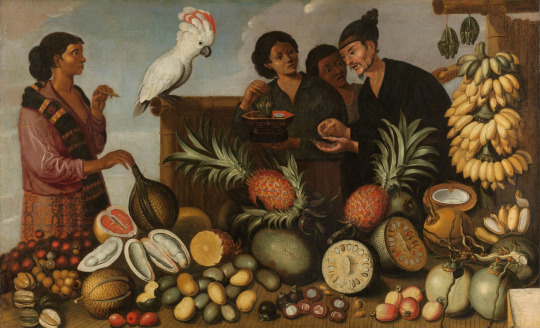
A Market Stall in Batavia, Andries Beeckman (attributed to), Albert Eckhout (rejected attribution), c. 1640 - c. 1666
The Dutch and Malay inscriptions on the piece of paper in the lower right corner identify this as a Dutch painting of subjects studied on the spot. Most of the fruit varieties are found only in Indonesia, the former Dutch East Indies, and were not exported to Europe at the time. The combination of figures from different countries suggests that the setting is most probably the very cosmopolitan Batavia, modern-day Jakarta.8 A Chinese merchant, recognizable as such from his distinctive goatee, moustache and remarkably long fingernails, is counting coins in a fruit stall set off with bamboo partitions. Standing on the left is a woman wearing a typically Javanese sarong and kebaya and holding a small cigar in one hand while placing a durian upright with the other. A second Javanese woman in the middle is lifting a small bundle of leaf wrappers out of a small Japanese lacquered casket, probably betel leaves. A boy behind her is picking a banana from the bunch hanging on the right. A striking salmon-crested cockatoo (Cacatua moluccensis) is perched on the bamboo screen at the back.
Andries Beeckman went to great lengths to depict the huge diversity of tropical fruit as faithfully as possible, but he was clearly not a professional still-life painter. The different varieties are easily distinguished, but their textures are not convincing. Laid out on the table – some with numbers matching the list on the piece of paper (the latter are given between brackets below) – are, on the far left, from top to bottom, rambutans (Nephelium lappaceum, no. 1), langsats (Lansium domesticum, no. 3) and starfruit (Averrhoa carambola, no. 2). Beside them are a partly cut pomelo (Citrus maxima, no. 4) and durians, one of them sliced (Durio, no. 5). The three small pieces of red fruit at bottom left are water or Malay apples (Syzygium aqueum or Syzygium malaccense, no. 6) or Java apples (Syzygium samarangense), and lying to their right are mangoes (Mangifera indica, no. 7) and pineapples (Ananas comosus, no. 8). Below the two pineapples in the centre are jackfruit, one halved (Artocarpus Heteropyllus, no. 9) and several small mangosteens, some opened (Garcinia mangostana, no. 10). On the right are bananas (no. 11), five coconuts and a halved one (Cocos nucifera), and at the very front cashew apples (Anacardium occidentale). The fruit cut in two in the Japanese casket is probably a sort of lime called a Calamondin orange (Citrofortunella microcarpa).
The Rijksmuseum painting is a reduced version of a canvas from an anonymous series of scenes of foreign peoples and produce that decorated the walls of Schloss Pretzsch an der Elbe in Saxony until 1828 (fig. a).9 In the nineteenth century they were removed, first to Berlin and then to Schloss Schwedt an der Oder in Brandenburg.10 They were seen there in the 1930s by Thomsen, who rather hesitantly attributed them to Albert Eckhout and dated them around the middle of the seventeenth century.11 Schwedt was completely destroyed in the closing days of the Second World War, and all that is left of the works of art are pre-war black-and-white photographs making it clear that the attribution to Eckhout is untenable.12
The connection with the canvas from Schloss Pretzsch also led to this Market Stall in Batavia being wrongly attributed to Eckhout or his circle in the past.13 It is woodenly executed, compositionally clumsy, and is not of the kind of Brazilian subject for which Eckhout is known. Minor differences between the two paintings show that they were not copied after each other but seem to share the same or a similar source. The way in which the fruit and cockatoo are depicted displays a clear resemblance to the only known still life by Andries Beeckman (fig. b), and, interestingly, one of the scenes from the series in Pretzsch castle was definitely based on watercolours by him,14 so the present canvas could also be by Beeckman or someone from his circle.
Very little is known about the picture’s provenance, although there are a few early records of an Indonesian fruit market, and since A Market Stall in Batavia is the only surviving work of that nature there is a great temptation to associate it with those early sources. There is, however, nothing that can be said for certain. Around 1660 Jan Vos wrote an ode about paintings in the collection of Joan Huydecooper, among them an ‘East Indies fruit market’: ‘Who has driven me from the north to the east? / I find myself in the market of the East Indies coast. / Here nature displays her fruit as food for life. / The sight makes my mouth desire the beautiful harvest, / Thus is my stomach now sorely overburdened. / Greedy eyes are not soon satiated’.15 It may well be that the poet was referring to the Rijksmuseum canvas.16 There is a second mention of an ‘East Indies fruit market’ a little later in the collection of burgomaster Mattheus van den Broucke of Dordrecht.17 It is far from obvious that it refers to this Market Stall in Batavia. His picture was one of a series of which the others were described as ‘One ditto, with East Indies animals and fruit’, ‘One ditto, being East Indies lodgings, ‘One ditto’, ‘Three ditto, East Indies women’ and ‘A Moorish woman’.18 It is very possible that the Rijksmuseum painting was also part of a larger ensemble of that kind.
Erlend de Groot, 2022
#hanfu#indonesia#art#sarong#Andries Beeckman#kebaya#懒收巾#jingguan#headwear#dutch painting#A Market Stall in Batavia
76 notes
·
View notes
Text

Mango Mussolini says he loves tariffs. I don’t think he really know much about tariffs.
A key point to understand is that a tariff affects the exporting country because consumers in the country that imposed the tariff might shy away from imports due to the price increase. However, if the consumer still chooses the imported product, then the tariff has essentially raised the cost to the consumer in another country.
3 notes
·
View notes
Text
Discover the complete guide to mango export from India, including market trends, major exporters, and essential documentation. Explore the profitability and growth potential of mango exports, backed by accurate data and insights from Seair Exim Solutions.
#mango export from india#mango export data#mango exporters#mango export from india to usa#mango exporter#mango exporting countries#mango hs code
0 notes
Text

Greenhouse agriculture
While Lufasa is a country with temperate climate, but a cultural legacy tied to the tropics, many ingredients of traditional meals are tropical fruits, with even the word for "holiday meal" in the national language Ohnaucan being kementsa duce or literally "pineapple meal". These crops of course can't be grown in the open like in their ancestral lands.
As a result, greenhouses are employed, where bananas, pineapples, mangoes, and in fact make Lufasa the largest (and in fact, only) producer of tropical fruits on Ystel. They are exported widely across the continent and beyond, and are part of why the country despite its small size is the regional agricultural powerhouse.
Researchers at the University of Eršaj in the capital of the same name are constantly researching ways to adapt these crops better to the local conditions, to increase yields and improve flavor, shelf-life and nutritional benefits, as well as work on bettering the greenhouses, their construction, ventilation, microclimate etc..
Image source: The Small Greenhouse, Quarry Bank Mill Upper Garden by David Dixon, CC BY-SA 2.0 https://creativecommons.org/licenses/by-sa/2.0, via Wikimedia Commons
2 notes
·
View notes
Text

GODDESS - OF THE - PHILIPPINE - ISLANDS -
MUTYA - NANG - PILIPINAS - 2012 - KNOWN -
4 - HEIGHT - BEAUTY - KINDNESS - TALENT -
LOVE - OF - COUNTRY - AND - ITS - NEVER -
ENDING - HARVEST - AND -
BEAUTIFUL - PEOPLE - PH -
2 - REPRESENT - THE - TRUE - MEANING -
OF - TOURISM - COME - SEE - MY - TRULY -
WONDERFUL - AND - SPECTACULAR -
COUNTRY - AND - HOW - GREAT OUR -
PEOPLE - ARE - OUR - CHILDREN -
THE PRIDE - OF THE PHILIPPINES -
AGAIN - WINNER - OF - MISS TOURISM -
NO - ONE - LIKE - US - LAST - WON - IN -
YEAR - 2000 - KUYA BOY - BEING - YES -
A - MAN - FRUSTRATION - OF - THESE -
FEMALE - BEAUTY - PAGEANTS - LIKE -
WHAT - WE'RE - WINNING - IN FUTURE -
LIKE - MISS VENEZUELA - NO 1 - RIGHT -
NOW - WE'RE - ALSO - WINNING -
MISS EARTH
LIKE - CATRIONA GRAY - DISMISSED BY -
THE - JEALOUS - BOTH - LOST - AND PH -
WON - MISS WORLD - WHO - CAN - BE -
NAKED - IN - PLAYBOY - MAGAZINES 2 -
CATRIONA - MISS UNIVERSE 2018 - US -
RIZZINI ALEXIS GOMEZ - MS TOURISM -
2012 - GLAD - DEATH - DOESN'T TRUE -
REMOVE - TITLE - REFUND REQUIRED -
2 - RIZZINI GOMEZ - INDEED GODDESS -
5'9 FT - AGE 25 BORN VISAYAS ISLAND -
CEBU CITY - BEAUTIFUL - CEBUANA -
SAME CITY - THE - UNFORGETTABLE -
WHITE - BEACHES - DRIED - MANGOS -
WORLD - EXPORT - MALE - PINOY -
WRITER - MUSIC - AND - WORDS -
FOLK - LOVE - SONG - BECAME -
NO 1 - WITH - MEMORIAL - ALL -
OVER - PILIPINAS - STILL - THE -
SAME - TODAY - 'MATUD - NILA' -
2 U - AGE 25 - YOUR - DEPARTURE -
AND - ASTRO - FORMER MEMBER -
MOON BIN - 6 FT - KOREAN BORN -
31ST - KOREAN - STAR - AT LEAST -
SUICIDE - HARSH - CONTRACTS -
NO - MARRIAGE - NO - DATING -
NO - FAMILY - NO - RELATIVES -
IN - EXCHANGE - FOR - MONEY -
KOREAN - WON - WHEN - ITS -
ABOUT - FAMILY - WHY - WE -
DO - SO - WELL - IN - THIS -
LIFE - IT - IS - ABOUT - OUR -
FAMILIES - WHY - WE LOVE -
WHY - WE - LIVE - WELL AS -
ALSO - AGE 25 - LIKE - CHRISTMAS -
25 DAYS - B 4 - SANTA CLAUS - YES -
COMES - 2 - TOWN - WITH - GOOD -
OLD - RUDOLPH - THE - RED NOSE -
REINDEER - AS - KIDS - ARE ASKED -
'HAVE - U - BEEN - NAUGHTY - OR -
NICE' - AND - WE - ANSWER - 'WE -
ARE - NICE' - OR - 'WHAT - DO - U -
KNOW - ALREADY - SANTA' - YES -
NOELLE - SANTA's - ONLY - DAUGHTER -
SAID - 'U - KNOW - I'M - ALWAYS - NICE -
DADDY' - SANTA - SAID - 'OF - COURSE -
U R' - 'MY - DAUGHTER - NOELLE' - YES -
SANTA - ALSO - HAS - HER OLDER BRO -
HIS - SON - NICK - AKA - NICHOLAS - 2 -
MOON BIN - 6 FT - HIGHEST - HEAVENS -
3 LEVELS - WITH - JONGHYUN - DO YOU -
KNOW - EACH - STAR - IS - LARGER -
THAN - THE - MOON - ALREADY XO -
NAMED - BY - OUR - GOD - OUR HAI -
HEAVENLY - FATHER - MOON BIN A -
CHILD - ALSO - OF - THE - LIVING -
GOOD - IS - NOT - A - THING - YES -
IN - SPACE - LARGER - THAN THE -
MOON - HE - AIN'T - FAT - AS YES -
KOREANS - ALSO - BELIEVE - IN -
REINCARNATION - ALREADY - ASSIGNED -
MOON BIN - AS - A - FAT - HUGE - LIKE A -
MONSTER - GIGANTIC - TUB - BIGGER -
THAN - THE - MOON - WHERE - HE - IS -
RIGHT - NOW - FLIRTING - WITH SULLI -
AND - GOO HARA - HANGING - OUT -
WITH - JONGHYUN - PLANNING XO -
THEIR - HEAVENLY - CONCERT -
TOGETHER - MET - GOREO AND -
JOSEON - MAIDS - SERVANTS & -
PRINCESS - THAT - WAS - HANGED -
EXECUTED - BY - ORDER - OF HER -
MALE - ROYAL - COUSIN - AND YES -
MORE - MET - HER - MAJESTY THE -
QUEEN - HER - QUEEN - MOTHER -
HER - HUSBAND - THE - KING HIS -
MAJESTY - LEFT - HANDED STILL -
MOON BIN - AMONG - BETTER -
PEOPLE - BETTER - COMPANY -
REPUBLIC - OF - KOREA - AND -
HARSH - LAWS - DID - HE YES -
MOON BIN - FINISH - 2 YEARS -
MILITARY - SERVICE - OR NOT -
SKIPPED - LIKE - JONGHYUN -
OR - HE - FINISHED MILITARY -
SERVICE - 2 YEARS - WON'T -
GO THERE - JESUS IS LORD -
NO - ONE - PROTESTS - MILITARY -
SERVICE - 4 - MEN - MALES - BUT -
WE - PROTEST - WHEN - MAKE - 4 -
YEARS - THEIR - HIGH SCHOOL - 4 -
CAN'T - MARRY - SMOKE - DRINK -
SO - THERE - KOREAN - SERVICE -
DURING - MARRIAGE AGE - BOO -
BIBLE - 'WHAT - GOD - HAS - JOINED -
TOGETHER - LET - NO - MAN - TRUE -
SEPARATE' - MAN - BEING -
NON-VIRGIN - MALES - IN -
AUTHORITY
NON-VIRGIN - MALES
WEDNESDAY - BY - MARRIAGE - INDIRA -
GANDHI - 2 BROS - HER MOST TRUSTED -
FOREIGN - GUARDS - LOADED - 2 - YES -
FIREARMS - IN - HER - RESIDENTIAL -
GROUND - ON - HER - WAY - 2 OFFICE -
THERE - 5'4 FT - FIRED - 20 BULLETS -
WEDNESDAY - ALLOWED - JUNE HIS -
BIRTHDAY - AT - MIDNIGHT - COLUMBIA -
MERCENARIES - FORMER - THEIR ARMY -
FLORIDA - NATURALIZED - COLUMBIANS -
THEIR - INTERPRETERS - ALL - SPOKE -
SPANISH - FIRED - 12 TIMES - IN - HIS -
OFFICE - INCLUDES - HEAD - RANSACKED -
PLACE - HEADED - 2 - HIS - COLLEGE YES -
SWEETHEARD - SHOT - ONCE - 4 - SHE -
MARRIED - HIM - RANSACKED - THEIR -
BEDROOM - TIED - UP - HOUSEHOLD -
STAFF - BOO - HOO -
WEDNESDAY - MOON BIN - 6 FT - 31ST -
KOREAN - STAR - DEPARTED - KOREA -
GANGNAM - SEOUL - KR - CHINESE YR -
OF - THE - TIGER - 1998 - HOLY GHOST -
BIBLE - 'TEACH - US - ALL - THINGS' -
SHARED - KINGDOM - OF THAILAND -
NO - FEMALE - ALLOWED - GUNS - 2 -
DEFEND - THEMSELVES - BUT GIVES -
WEAPONS - 2 - MEN - HUNTING YES -
SEASON - 2 - KILL - TIGERS - GRAY -
ELEPHANTS - GOD - BEAUTIFUL XO -
WILD - ANIMALS - 30,000 - GIRLS -
RAVAGED - KNOCKED UP - ALSO -
PER - YEAR - SPANISH - KING - 2 -
GIRLS - NOT - ALLOWED - GUNS -
ASSAULT - WEAPONS - CAN'T SP -
DEFEND - THEMSELVES - WEAPONS -
4 - MEN - HUNTING - SEASON - KILL -
WILD - ANIMALS - OVER - 243,000 -
WOMEN - RAVAGED - KNOCKED UP -
EACH - YEAR - REMEMBER - I GAVE -
PHOTO - OF - TIGER - MOON BIN - IS -
CHINESE - YEAR - OF - THE - TIGER -
DEPARTED - WED - 19 APRIL 2023 -
BUT - JONGHYUN - DEPARTED - M -
HANUKKAH - 18 DEC 2017 - 19TH IS -
DAY - AFTER - HOW - ABOUT - THAT -
AFTER - THE - EASTER - BUNNY -
HOPPED - WORLDWIDE - 2 - YES -
DELIVER - EASTER - EGGS TRUE -
VERY - ROMANTIC - MOON - BIN -
WE - WILL - MISS U - BEAUTIFUL -
MOON - UNTIL - WE - ALL - MEET -
AGAIN - HIGHEST - HEAVENS -
JONGHYUN - SULLI AND GOO -
UNTIL - WE - ALL - GET - YES -
TOGETHER - AGAIN - MICKEY -
MOUSE - CLUB - MOON - BIN -
'M - I C - (SEE - U - REAL - SOON) -
KEY' - (WHY - BECAUSE - WE LUV -
YOU) - 'MOUSE' - EVEN - WALT DISNEY -
IS - THERE - WHO - ALWAYS - PAID FOR -
THE - IMPOSSIBLE - 'UNTIL - THEN' -
MOON BIN - 6 FT - 'WE'LL - KEEP ON -
SINGING' - KOREA - 'FIGHTING' - (25)
2 notes
·
View notes
Text
Coffee Tour at Doka Farm
In the morning I was treated to a very early, very cold shower in temperatures that were definitely not the 30 degrees of Jaco! I packed my day bag quietly for my tour and then sat in the main living room where there was a little cat curled up asleep that I must not have noticed last night. The driver was right on time for pick up and I was the first person so had my pick of the seats, although he asked me to sit right behind him. I sat there until we arrived at the next hotel for pick up but it was too cold and windy there to do it all day! It was cool to see the city of San Jose wake up and come alive at 6am as we drove through the streets to pick up all the tour participants. Everyone walking around was carrying an umbrella – it was a 100% chance of rain today, and they seem to trust the forecast! One queue at a bus stop ran all the way down the street, around the corner and down the next street, it was organized mayhem! Our driver introduced himself as our tour guide Max who had his first coffee at 6 months old. He told us that the traffic is crazy in San Jose because 2 million people visit everyday but luckily we were heading out the opposite direction. Once everyone was picked up, our last folks were picked up from an airport hotel, Max gave us the itinerary break down for the day. We’d be spending it in the Alajuela province which is famous for its mango which is unfortunately not in season! Our day began with a visit to Doka coffee farm owned by the Vargas family at 5000 feet. On the drive us Max gave us all the facts about Costa Rican coffee – it’s Arabica only, 95% of Costa Rican coffee is exported to other countries, coffee grown at 3000 feet tastes like citrus and coffee grown at 6000 feet tastes like sweet fruits. Max also told us about how he gets woken up at 4am everyday by his 2 cats Catalina and Nutella – one cat has another house though. As we drove further up into the coffee plantations Max explained how coffee productions is one of the biggest industries for migrant workers from Nicaragua. 200,000 Nicas work in coffee plantations in Costa Rica, another 200,000 work in banana plantations, and 200,000 more in pineapple plantations. These migrants get around $20 a day, which is much better than the $4 a day they would get in agricultural work in their home country just across the border. They are also given housing as part of their employment since they do the work that Costa Ricans are unwilling to do. At the Doka coffee farm, we started with our buffet breakfast where I finally tried gallo pinto on my last full day in Central America! I also piled up my plate with fried plantains, sausage slices, a tortilla and some fruit. They had 3 black coffees on offer, made from their own coffee beans. The standout was the Peaberry which I ended up buying a bag of to take home with me.
Max took us on a tour around the plantation, we first saw the peeling machine that has worked for 160 years without electricity and Max explained how the coffee harvest is synced with the school year so that the teenagers can also come to help pick the cherries when all hands on deck are needed. A sack of Costa Rican green coffee beans, washed, peeled and dried, goes for about $300 but up to $4000. In comparison the average price of a sack of Brazilian robusta beans fetches $100 meanwhile the most expensive sack is a geisha tree specialty from Panama which sold for $200,000. The peaberry is also more expensive as it’s a perfectly formed seed but smaller than average, they need to be handpicked out of the regular seeds. Max explained that the sweetest coffee is grown at the higher altitudes, but the honey process can also lead to sweeter coffee. The honey process involves leaving the greasy layer on the beans rather than letting them ferment to wash it off. When it dries, the honey process will take 12 days to dry the greasy layer too whereas the fermented beans would only take 5 days. The beans are all dumped outside in the sun to dry, with the workers walking through the beans with a rake to move them around for even-drying. After the tour we were led purposefully to the gift shop where I purchased the peabery blend for just $9 as well as some chocolate coated coffee beans for Alanna. We then piled back into the van to our next destination - the Poas volcano.
2 notes
·
View notes